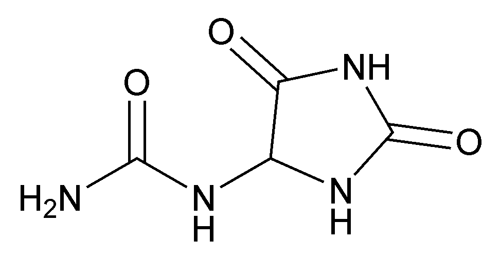Allantoin
» Allantoin contains not less than 98.5 percent and not more than 101.0 percent of C4H6N4O3.
Identification—
B:
Thin-Layer Chromatographic Identification Test  201
201 —The RF value of the principal spot obtained from Test solution 1 in the test for Related compounds corresponds to that of the principal spot obtained from Standard solution 1.
—The RF value of the principal spot obtained from Test solution 1 in the test for Related compounds corresponds to that of the principal spot obtained from Standard solution 1.
C:
Add 20 mg of Allantoin to a mixture of 1 mL of 2 M sodium hydroxide and 1 mL of water. Heat to boiling, allow to cool, and add 1 mL of 2 M hydrochloric acid. To 0.1 mL of this solution add 0.1 mL of potassium bromide solution (1 in 10), 0.1 mL of resorcinol solution (2 in 100), and 3 mL of sulfuric acid. Heat on a water bath for 5 to 10 minutes: a dark blue color, which turns red after cooling and pouring into about 10 mL of water, is observed.
Angular rotation  781A
781A :
:
 between
between  0.10
0.10 and +0.10
and +0.10 .
.
Test solution:
 10 mg per mL, in carbon dioxide-free water. [note—Reserve a portion of this solution for use in the test for Acidity or alkalinity.]
10 mg per mL, in carbon dioxide-free water. [note—Reserve a portion of this solution for use in the test for Acidity or alkalinity.]
Acidity or alkalinity—
To 5 mL of the Test solution retained from the test for Angular rotation add 5 mL of water, 0.1 mL of methyl red TS, and 0.2 mL of 0.01 M sodium hydroxide: a yellow color is observed. Add 0.4 mL of 0.01 M hydrochloric acid: the solution turns red.
Loss on drying  731
731 —
Dry it at 105
—
Dry it at 105 to constant weight: it loses not more than 0.1% of its weight.
to constant weight: it loses not more than 0.1% of its weight.
Residue on ignition  281
281 :
:
 not more than 0.1%.
not more than 0.1%.
Reducing substances—
To 1.0 g of Allantoin add 10 mL of water, shake for 2 minutes, and filter. Add 1.5 mL of 0.02 M potassium permanganate: the solution remains violet for at least 10 minutes.
Related compounds—
Adsorbent:
 cellulose.
cellulose.
Test solution 1—
Transfer about 0.10 g of Allantoin, accurately weighed, to a 10-mL volumetric flask, add 5 mL of water, dissolve by heating, and allow to cool. Dilute with methanol to volume, and mix. [note—Use immediately after preparation.]
Test solution 2—
Transfer 1 mL of Test solution 1 to a 10-mL volumetric flask, dilute with a mixture of methanol and water (1:1) to volume, and mix.
Standard solution 1—
Transfer about 10 mg of USP Allantoin RS, accurately weighed, to a 10-mL volumetric flask, dissolve in and dilute with a mixture of methanol and water (1:1) to volume, and mix.
Standard solution 2—
Transfer about 10 mg of USP Urea RS, accurately weighed, to a 10-mL volumetric flask, dissolve in and dilute with water to volume, and mix. Transfer 1.0 mL of this solution to a 10-mL volumetric flask, dilute with methanol to volume, and mix.
Standard solution 3—
Mix 1 mL of Standard solution 1 and 1 mL of Standard solution 2.
Developing solvent system:
 a mixture of butyl alcohol, water, and glacial acetic acid (60:25:15).
a mixture of butyl alcohol, water, and glacial acetic acid (60:25:15).
Spray reagent—
Dissolve a quantity of p-dimethylaminobenzaldehyde in a mixture of methanol and hydrochloric acid (3:1) to obtain a solution having a concentration of 5 g per L.
Procedure—
Proceed as directed for Thin-Layer Chromatography under Chromatography  621
621 . Separately apply to the chromatographic plate 10 µL of Test solution 1 and 5 µL each of Test solution 2, Standard solution 1, Standard solution 2, and Standard solution 3. Develop the chromatogram until the solvent front has moved about 10 cm. Spray the plate with Spray reagent, dry in a current of hot air, and after 30 minutes examine under visible light. Any spot in the chromatogram obtained from Test solution 1, except for the principal spot, is not more intense than the spot in the chromatogram obtained from Standard solution 2: not more than 0.5% of any individual impurity is found. The test is not valid unless the principal spots in the chromatogram obtained from Standard solution 3 are clearly separated.
. Separately apply to the chromatographic plate 10 µL of Test solution 1 and 5 µL each of Test solution 2, Standard solution 1, Standard solution 2, and Standard solution 3. Develop the chromatogram until the solvent front has moved about 10 cm. Spray the plate with Spray reagent, dry in a current of hot air, and after 30 minutes examine under visible light. Any spot in the chromatogram obtained from Test solution 1, except for the principal spot, is not more intense than the spot in the chromatogram obtained from Standard solution 2: not more than 0.5% of any individual impurity is found. The test is not valid unless the principal spots in the chromatogram obtained from Standard solution 3 are clearly separated.
Assay—
Transfer about 120 mg of Allantoin, accurately weighed, to a 100-mL beaker, dissolve by stirring in 40 mL of water, and titrate with 0.1 M sodium hydroxide. Determine the endpoint potentiometrically, using a suitable electrode system (see Titrimetry  541
541 ). Each mL of 0.1 M sodium hydroxide is equivalent to 15.81 mg of C4H6N4O3.
). Each mL of 0.1 M sodium hydroxide is equivalent to 15.81 mg of C4H6N4O3.
Auxiliary Information—
Please check for your question in the FAQs before contacting USP.
| Topic/Question | Contact | Expert Committee |
| Monograph | Feiwen Mao, M.S.
Scientist 1-301-816-8320 |
(MDOOD05) Monograph Development-Ophthalmics Oncologics and Dermatologicals |
| Reference Standards | Lili Wang, Technical Services Scientist 1-301-816-8129 RSTech@usp.org |
USP32–NF27 Page 1450
Pharmacopeial Forum: Volume No. 27(5) Page 2973

